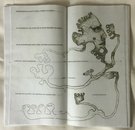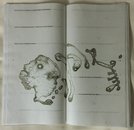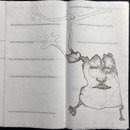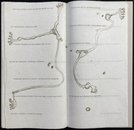Le Murmure: condition et destin de l’artiste.
Mutel, Didier and Francis Ponge. Le Murmure: condition et destin de l’artiste.
Paris: Didier Mutel, 2001.
24 x 12 cm. 64 leaves. Gray paper wrappers, with an extra bifolium serving as endpapers, spine printed in black “Le murmure Francis Ponge”, housed in a gray paper covered slipcase. Includes five original etchings printed in black by Didier Mutel. The entire text was photoengraved and reworked on copper plates and printed on 31-gram Japanese Sekishu shi paper. Based on Ponge’s original edition (Lyon: Henneuse, 1954), Mutel’s edition was designed and printed by the artist in 2001.
The edition created at the request of L'Association Internationale de Relieurs, consists of 99 copies; 84 copies numbered 1-84, 10 copies for collaborators that include an original drawing by Mutel and numbered I-X, and 5 copies reserved for copyright deposit; all copies numbered and signed by Didier Mutel.
Le Murmure belongs to an early period in Mutel’s career when he combined engraving with previously published literary texts by authors such as Lewis Carroll, Franz Kafka, Guy de Maupassant, Saint-John Perse, Robert Louis Stevenson, and Stefan Zweig, whereas his more recent work is characterized by his own original compositions and concept driven productions.
The abstract and anthropomorphic figures that Mutel engraved for this text are a response to Francis Ponge’s philosophical meditation on the meaning of art and humankind’s compulsion to express itself through imagery, metaphor, symbol, music, and dance. The title of the work—Le Murmure, a murmur or a whisper—echoes Ponge’s subtle exploration of the “condition and destiny of the artist” just as Mutel’s choice of materials—ephemeral Japanese paper—typeface—a small, unassuming sans serif—and illustrations—free-flowing whispered forms, organically developing on the page out of the seedbed of Ponge’s words.
Ponge, like Mutel, is interested in thinking about the artist’s place in the world, as reflected in the excerpt below:
L'humanité enfin aura le même destin que ses artistes.
Seule (aux hommes comme aux œuvres) permet de vivre
Une insubordination résolue aux idées.
L’homme n’est pas le roi de la création. Non, du tout.
Plutôt son persécuteur. Persécuteur persécuté.
D’autant que, par son activité à la dominer,
Il risque de s’aliéner le monde, il doit à chaque instant,
Et voilà la fonction de l’artiste,
Par les œuvres de sa paresse se le réconcilier.
[Finally, humanity will have the same destiny as its artists.
Alone (men as well as artworks) allowed to live
A resolute insubordination to ideas.
Man is not the king of creation. Not at all.
Rather its persecutor. Persecutor persecuted.
Especially since, by his activity to dominate it,
He risks alienating the world, He must at every moment –
and this is the role of the artist - reconcile himself to the world
with the œuvres of his idleness.]






